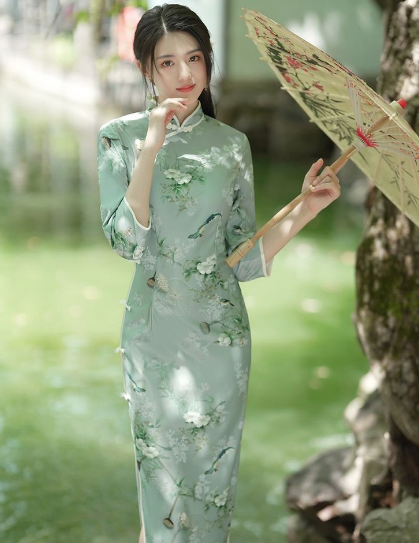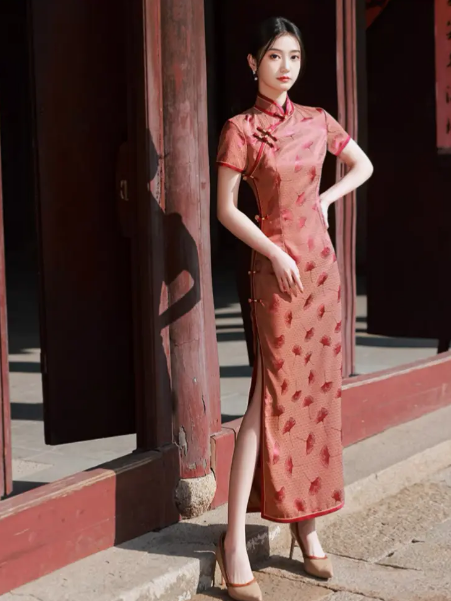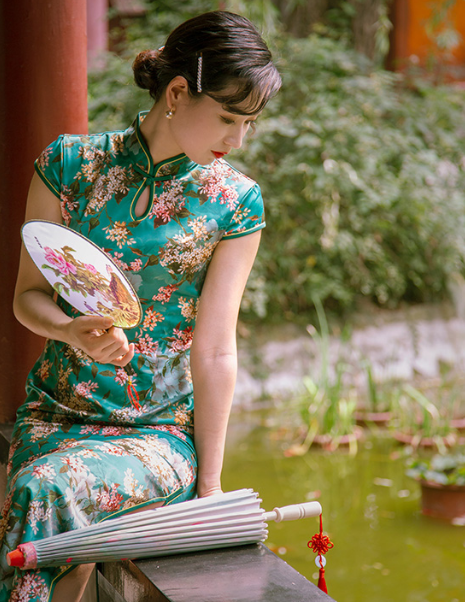Understanding the Cheongsam
The cheongsam, also known as qipao, stands as a symbol of Chinese fashion elegance. Originating from the Qing Dynasty (1644–1912), it has undergone significant transformations. Traditionally made of silk, with high collars and a snug fit, the cheongsam showcases the gracefulness of the wearer, often highlighting their modesty and delicate beauty.
Historical Background
The cheongsam’s journey began in the 17th century, reflecting Manchu women’s clothing styles. Originally a loose-fitting dress, it provided ease of movement and modest coverage. Over time, social and cultural shifts influenced its design, tailoring it closer to the body, and incorporating varying sleeve lengths and decorative patterns. This evolution mirrored changes in Chinese society, particularly in women’s roles and self-expression. Qing Dynasty fashion shifted from strictly traditional designs to more innovative ones, influenced by political and cultural interactions with other countries.

Evolution and Modern Interpretations
The 20th century brought drastic changes to the cheongsam, particularly in the 1920s and 1930s in cosmopolitan Shanghai. Young, urban women started to favor this dress, now epitomizing modernity, fashion, and femininity. The transformation involved tighter fits, shorter hemlines, and various sleeve styles, aligning with global fashion trends. Today, designers blend traditional elements with new materials, patterns, and cuts, introducing the cheongsam to international fashion runways. Contemporary variations often mix western and eastern styles, demonstrating versatility in fabric choices (from silk to cotton and linen) and adaptations for different body types and occasions. This fusion has made the cheongsam not just a garment, but a canvas reflecting cultural diversity, fashion innovation, and artistic expression.
Traditional Occasions for Wearing Cheongsams
Cheongsams, with their elegance and grace, often feature in traditional Chinese settings. People primarily choose them for formal occasions, respecting their deep cultural roots and aesthetic appeal. They symbolize cultural pride and elegance, making them ideal for important celebrations.
Chinese Festivals and Celebrations
During significant festivals like the Chinese New Year, Mid-Autumn Festival, and Dragon Boat Festival, wearing a cheongsam connects individuals to their heritage. Especially during the Chinese New Year, many opt for red cheongsams, as red symbolizes good fortune and joy in Chinese culture. Embroidered designs, incorporating symbols like dragons, phoenixes, and flowers, add auspicious meanings. Chinese New Year customs often highlight the importance of new attire, signifying new beginnings and blessings for the year ahead.
Weddings and Formal Gatherings
At weddings, brides often choose a red cheongsam as part of their attire, symbolizing love, joy, and prosperity. They may prefer intricate designs, fine silk materials, and exquisite craftsmanship, underscoring the importance of the occasion. Even guests might wear less ornate cheongsams, adhering to the formal nature of the event. Besides weddings, cheongsams also grace other formal gatherings like anniversary celebrations or company banquets. Their timeless elegance, coupled with modern styles and fabrics, allows for a perfect blend of tradition and contemporary fashion. The choice of fabric, design, and color largely depends on the occasion’s nature and the wearer’s preference, showcasing a harmonious blend of tradition and personal style.
Cheongsams in Contemporary Fashion
In today’s fashion, the cheongsam has evolved from a traditional Chinese dress to a symbol of modern style and versatility. Designers often experiment with different fabrics, cuts, and patterns, making the cheongsam a popular choice not only for formal occasions but for everyday wear as well.
Daily Wear and Casual Styling
For daily wear, contemporary cheongsams blend comfort with style. Designers might use softer, more breathable fabrics like cotton or linen, ideal for daily activities. Simplified versions with looser fits, shorter lengths, and simpler patterns suit the casual, fast-paced lifestyle. These adaptations make the cheongsam more accessible and wearable, integrating traditional elegance into modern wardrobes. Women often pair them with casual footwear like flats or sneakers and minimal accessories, creating a look that’s both stylish and practical. This fusion ensures that the cheongsam remains a relevant and cherished garment in the everyday fashion scene.
High Fashion and Designer Trends
In the realm of high fashion, the cheongsam signifies luxury and sophistication. Top designers often reimagine this iconic dress with innovative designs, luxurious fabrics, and bold patterns. They might incorporate elements like unconventional necklines, asymmetric cuts, and mixed materials, presenting a contemporary twist to the classic silhouette. These modern interpretations often appear on global fashion runways, in celebrity wardrobes, and at prestigious events, making a distinct statement. They embody a blend of East and West, tradition and innovation, appealing to a broad, style-conscious audience. By constantly evolving, the cheongsam remains at the forefront of fashion, continually redefining elegance and heritage.
Cultural Significance and Respect
The cheongsam, beyond being a fashion statement, carries deep cultural significance. It represents a rich history and is a symbol of Chinese identity and heritage. When wearing a cheongsam, it’s crucial to understand and respect its cultural importance, especially in an increasingly globalized world where cultural sensitivity is paramount.
Symbolism and Cultural Appropriation
The cheongsam is more than just an item of clothing; it’s a representation of Chinese culture and history. Each aspect of the cheongsam, from its silk fabric to the traditional patterns, tells a story deeply rooted in Chinese culture. When people outside the Chinese community wear a cheongsam without understanding its significance, it risks becoming a mere fashion trend, stripped of its cultural identity. This can lead to cultural appropriation, where the garment’s deeper meanings and origins are overlooked or misrepresented. Respectful engagement with the culture, including an understanding of the dress’s background and significance, is essential in avoiding cultural insensitivity.
Guidelines for Respectful Wear
Wearing a cheongsam respectfully means acknowledging its cultural heritage and considering the context in which it’s worn. It’s appropriate to wear a cheongsam at Chinese festivals, weddings, or cultural events where the dress is celebrated as part of the heritage. When wearing a cheongsam, one should avoid modifying it in ways that disrespect its traditional design. Pairing it with appropriate accessories and wearing it with an understanding of its cultural significance is key. By showing respect for the culture and the dress, wearers not only embrace its beauty but also honor the rich history and identity it represents.

Accessorizing the Cheongsam
Accessorizing a cheongsam can enhance its elegance and style. The right accessories not only complement the dress but also add a personal touch, reflecting the wearer’s taste and personality. Whether sticking with traditional accessories or experimenting with modern twists, the key lies in creating a harmonious and balanced look.
Traditional Accessories
Traditionally, accessories for the cheongsam include delicate jewelry, such as jade or pearl necklaces and earrings. These classic pieces highlight the cheongsam’s elegance without overpowering its design. Hair ornaments, like beaded hairpins or floral combs, can also enhance the overall look, especially for formal occasions. For footwear, embroidered silk shoes or simple, elegant heels usually complete the outfit. These traditional accessories underscore the cultural richness of the cheongsam, bringing a sense of authenticity and timeless grace to the ensemble.
Modern Twists and Combinations
Contemporary styling of the cheongsam allows for more creative and personalized accessorizing. Modern interpretations might include pairing the dress with statement jewelry, bold clutches, or even leather jackets for an edgy twist. Footwear choices have expanded to include stylish flats, ankle boots, or even sneakers for a casual, modern look. Integrating contemporary accessories with a traditional cheongsam can create a unique, eclectic style that respects the dress’s cultural roots while showcasing the wearer’s individuality. This fusion of old and new mirrors the evolving nature of fashion, where traditions blend seamlessly with modern trends.
Choosing the Right Cheongsam
Selecting the perfect cheongsam involves considering various factors such as body type, fabric, and pattern. The right choice not only enhances the wearer’s beauty but also ensures comfort and style, resonating with personal aesthetics and the occasion’s demands.
Selection Based on Body Type
To flatter different body types, the cheongsam should fit well and highlight the wearer’s best features. For those with a pear-shaped body, choosing a cheongsam with A-line skirts can balance the lower body’s width. For apple shapes, styles that define the waist and have a higher neckline can create a more harmonious silhouette. Slim or column-like body types can opt for fitted cheongsams that accentuate their slender figures. It’s also important to consider the length of the cheongsam; for example, taller individuals might choose longer lengths, while petite women might prefer shorter versions to elongate their stature.

Picking the Appropriate Fabric and Pattern
The choice of fabric and pattern significantly influences the cheongsam’s look and feel. Silk, with its luxurious sheen and smooth texture, is traditionally favored for formal events. However, for everyday wear, more practical and comfortable fabrics like cotton or linen are popular choices. The pattern on the cheongsam also plays a crucial role; larger prints can overwhelm a petite frame, while smaller, subtler patterns might be more flattering. For a modern touch, designers often experiment with bold colors and contemporary patterns, offering options that range from the classic and elegant to the modern and edgy. Considering the occasion, personal style, and comfort will guide you in selecting the ideal fabric and pattern for your cheongsam.